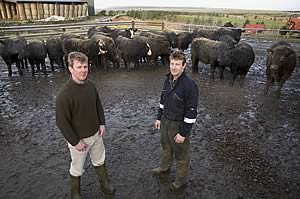 |
|||||||||
|
|||||||||||||||||||
|
|
Caithness
and Borders Top Aberdeen-Angus
Sucklers 31/01/07 Commercial beef herds in Caithness and the Borders have claimed the top two places in the annual Bank of Scotland Aberdeen-Angus Suckler Herd of the Year awards.
Overall winner is Hamish Pottinger, and sons, Michael and David, who run a 210-cow breeding and finishing enterprise at Greenland Mains, Thurso, Caithness, and runner-up – for the second time - Douglas Tweedie, whose 130-cow breeding and finishing enterprise is based at Middlethird, Gordon, Berwickshire. The judge, John Taylor, Bank of Scotland Corporate’s Director of Agriculture Scotland, said there was little to separate the two finalists. Both enterprises were good examples of the ongoing development potential of the Aberdeen-Angus breed for commercial producers. “Unfortunately, there can be only one winner and Michael just shaded it with a very good grasp of the financial and technical performance of his herd,” said Mr Taylor, who visited the farms on consecutive days at the beginning of January, with Ron McHattie, chief executive of the Aberdeen-Angus Cattle Society. “It was a case of two extremes with 80mph gales and lashing rain in Caithness and a sunny, almost balmy, spring-like day in the Borders,” said Mr Taylor. “Both farmers are to be congratulated on the quality of their businesses and livestock in quite contrasting parts of Scotland. Both are alive to the importance of delivering the spec required by their customers and are continuing to drive out further efficiencies in their businesses.” Mr Taylor added that the ever-increasing influence of the Aberdeen-Angus breed in both commercial herds had reaped a financial and technical improvement in performance. “There is an ever-increasing demand for Aberdeen-Angus beef at the quality end of the market and this can only be of benefit to the breed society and its members,” said Mr Taylor. “The recent well-publicised agreement with Burger King has the benefit of producing a premium market for that part of the animal which is of lower value.” The Pottinger family have switched 100% to Aberdeen-Angus bulls for crossing on their Aberdeen-Angus, Lincoln Red and Simmental cross cows because of the ease of calving, easy management advantages and longevity of the Aberdeen-Angus breed. They now run seven Aberdeen-Angus bulls, all Newcairnie-bred, and plan to maintain a closed herd with high health status. “The Aberdeen-Angus eat half as much as Continental crosses and are so easily calved,” says Michael Pottinger. “The calves are easily fleshed and grow into prime cattle which command a premium price per kg in the market place.” Cows are inwintered in straw bedded courts on a Total Mixed Ration of silage, home-grown barley, straw and minerals which is available ad lib from a bunker. Liveweight gain and grading has improved dramatically since the introduction of TMR compared with feeding silage and barley twice-a-day. Rapemeal is fed as the only protein to heifers and finishing cattle to grow the frame over the first winter. Summer grazing includes access to sandy links on a Site of Special Scientific Interest (SSSI) at Dunnet where grazing is restricted to three months of the year from mid-August until housing in November. Grazing has been greatly improved as a result of ploughing and reseeding over the past 10 years. Cows are calved in May/June and graze on rotational grass until safely in calf when they move to the sandy links. Heifers are calved at two years of age which the Pottinger’s view as an important economic advantage. This year 98% of the cows have been pregnancy diagnosed in calf. Cows not in calf are culled. All calves are finished on the farm – except heifers being retained as replacements – and are marketed to A K Stoddart Ltd, exclusive suppliers of Aberdeen-Angus beef to Costco. Most recent figures show steers averaging 363kg deadweight at 629 days (1.16kg DLWG) and grading R4L and 4H to gross £835 and heifers – after selecting the best as replacements - 285kg at 603 days (1.03kg DLWG) with similar grades to gross £640. “The profitability of our beef enterprise has increased each year with increased sales and has allowed substantial investment in buildings and grassland improvement,” says Michael. Mr Tweedie, who was runner-up in the competition two years ago, runs 130 Aberdeen-Angus cross cows, all put to Aberdeen-Angus bulls, on his 1000-acre lowland farm in the Borders. All calves are finished on the farm and sold to meat processors, Dovecote Park Ltd, exclusive suppliers of Aberdeen-Angus beef to Waitrose. Mr Tweedie has opted for Aberdeen-Angus because of their easy keep advantages and premium prices, averaging 225p/kg deadweight over the past year. Awards – including the Bank of Scotland Trophy and cash prize of £1000 to the winner – will be presented at the annual dinner of the Aberdeen-Angus Cattle Society at Perth on Monday (February 5).
| ||||||||||||||||||

|
|
||||||||||||||||||
| home | agri-services | pedigree
pen | news | dairy | beef | machinery BPS | property | organisations | site map |
|||||||||||||||||||


